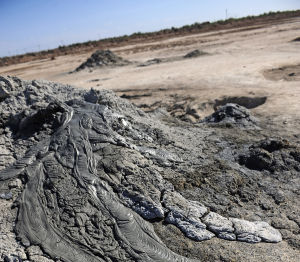Mud volcanoes are a treasure by the Salton Sea
By ALEXIS RANGEL, Staff Writer
Posted on November 24, 2013
SALTON SEA — Imperial Valley farmer Al Kalin recalls that as a boy, his folks would take him to interesting places throughout the Imperial Valley.
One of those places in particular was the mud pots and mud volcanoes near the Salton Sea.
"Back then you could drive to Mullet Island and the mud pots and mud volcanoes were on either side of the road going out to Mullet Island," Kalin said, "But then the sea came up and covered everything up."
These geological treasures are situated near various fault lines, where the earth's magma is close to the surface.
You can find them near areas with heavy geothermal activity.
Places like Imperial County, Cerro Prieto in Mexicali and the famous Yellowstone Park all have bubbling mud pots.
Near the Salton Sea, a shallow magma body causes carbon dioxide to form in the soil, said David K. Lynch with the U.S. Geological Survey's Earthquake Science Center in Pasadena.
"As it rises it carries mud," said Lynch.
Mud pots are far more common than mud volcanoes; however both endure the same process.
"Fine particles of clay are carried toward the surface by the carbon dioxide gas," Kalin said, "If the soil near the surface is saturated or there is a water table, mud pots are the result."
There could be dozens if not hundreds of mud pots near the Salton Sea that have been in the area for quite some time, said Lynch.
On the other hand, mud volcanoes are formed by globs of clay shooting upward.
"These small wet gobs slowly build upon each other and form a mud volcano," Kalin said.
Lynch said there is geological evidence to suggest mud pots have been forming in the area for 1,000 years.
These boiling pots can exceed 140 degrees.
"They can get hot so you should stay away from them," Lynch said.
As visitors view the steam rising from the vents of the boiling mud, they smell the nostril-curling scent of sulfur being emitted.
That smell is "probably generated by rotting vegetation in an anaerobic atmosphere near the surface," Kalin said.
Surrounding some of the mud volcanoes are small puddles of water.
The color of the water varies from one mud volcano having red water to another having green.
"The colors are probably formed by different minerals or even bacteria," Kalin said.
Kalin finds it fascinating that the mud volcanoes can be dormant for years and then quickly become active.
During research that Lynch conducted on recently exposed fumarole fields near Mullet Island, a mud volcano grew vertically by about 1 meter within a year.
It is indeed a sight to see and one that Kevin Marty, geology professor at Imperial Valley College, has taken a few students to see.
For Lynch, the mud volcanoes and pots are yet more ways to show the earth below is active.
--
__._,_.___

No comments:
Post a Comment